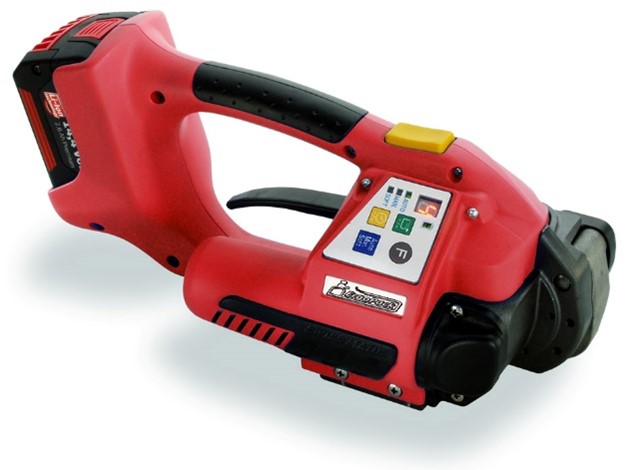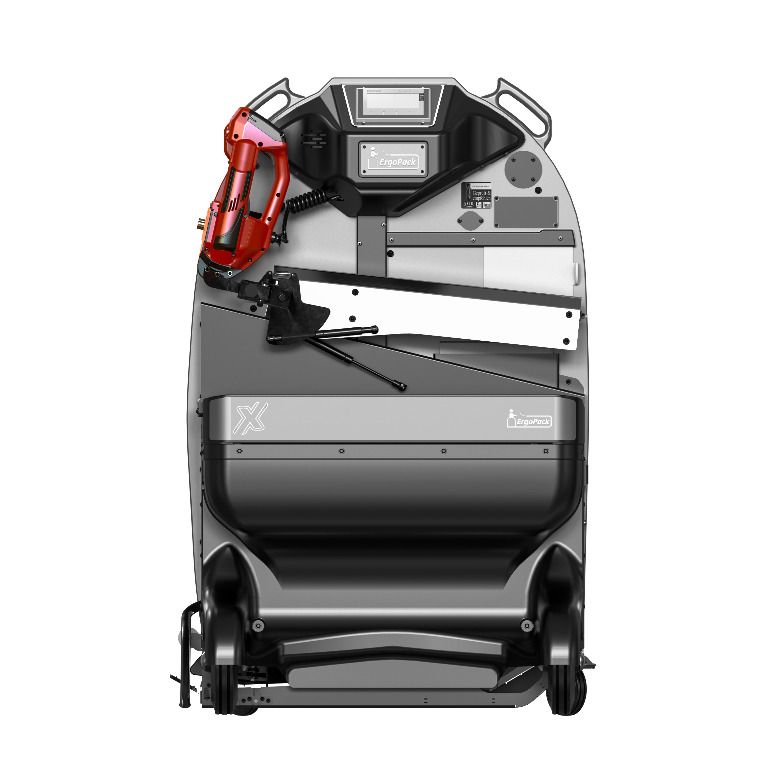Strapping Tool: Combining Safety and Efficiency.
To secure goods during transport, they are often strapped with a strapping band that must be reliably sealed. This is where strapping tools are commonly used—these devices securely seal plastic strapping using a friction welding process.
How does it work?
The load to be secured is first placed on a pallet or load carrier and then enclosed with a plastic strapping band. The strapping band is threaded into the strapping head, tensioned, and then sealed. This can be done either manually or using automatic mechanisms. Some strapping heads tension the band manually using a built-in tensioning system, while others rely on pneumatic or battery-powered (electric) systems to apply tension. Once properly tensioned, the band must be sealed to secure the package. Depending on the type of strap, this is done using friction welding for plastic straps or by manually or automatically applying metal seals in the case of steel strapping. Once secured, the load is ready for safe transport. Since there are various types of strapping tools, the exact functionality can vary depending on the model. The specific application area and the requirements for load securing also play an important role when selecting the appropriate strapping solution.
What options are available for sealing a strapping band?
Depending on the individual requirements for securing the load unit, the specific type of package, and the strapping material, there are different sealing options.
The most common methods are the plastic seal, where the band is compressed using a special tool or strapping device.
Metal seals are inserted into the band and then clamped tightly with pressure to securely fasten the strap.
The heat seal is used with certain plastic strapping bands. In this method, both ends of the band are heated so that the material melts and bonds together.
The friction welding process, used for plastic bands, works similarly. Friction generates heat that melts the band at the sealing point, and the ends are then pressed together to create a strong connection.
The choice of sealing method also depends on various factors such as the strapping material and the application, with each method offering its own advantages and disadvantages in terms of safety, cost, and efficiency.
What is the friction welding process and how does it work?
The friction welding process, also known as friction sealing, is used in strapping tools to weld plastic strapping bands. This is done by generating frictional heat between the surfaces of the band ends. The process secures the strapping tightly around the load to prevent shifting during transport. Once the strap has been placed around the pallet and the goods, it is threaded into the strapping head and tensioned. After tensioning, the friction welding process is activated. The heat produced at the contact point causes the plastic material of both strap ends to melt, and the tool then applies pressure to fuse them together. Once the welded area has cooled, a strong and secure bond is formed that holds the load safely in place during transport. The main advantage of friction welding is its speed and efficiency, as no additional sealing materials like metal clips are required to complete the strapping process.
What components are needed for strapping with a battery-powered sealing head?
Sealing heads are often powered by a rechargeable battery. However, the tool alone does not ensure proper load unit securing—it must be used in combination with several other components.
To secure the load, the primary item needed is a strapping band, which is wrapped around the package and then secured using the sealing head. The battery-powered sealing head is a portable device, powered by a battery, that tensions and seals the strap around the load.
In addition to a battery charger or spare batteries, a strapping dispenser or even an ErgoStrap system can be useful for applying the strap efficiently and—especially with ErgoStrap—ergonomically around the pallet. With these components, a battery-powered sealing head can provide fast and effective load securing, helping meet various packaging requirements.

What should be considered when maintaining a sealing head?
To ensure the longevity of a sealing head, regular maintenance is essential. The following points should be kept in mind:
- Train users: Proper training helps ensure that the sealing head is used correctly. During training, users can learn correct operation procedures and receive guidance on maintenance and safety protocols.
- Regular cleaning: Dust, dirt, and other debris should be carefully removed from the tool using a cloth or compressed air. This helps maintain the tool’s functionality over time.
- Check for wear and tear: Regularly inspect the tool's components for cracks, wear, or loosened parts. Early detection allows for timely replacement of worn parts, ensuring that the tool continues to seal straps reliably.
- Battery care: Follow the manufacturer’s instructions for charging and maintaining the battery. Proper care extends battery life and ensures consistent performance during the sealing process.
With consistent care and maintenance, the durability and reliability of a sealing head can be extended, ensuring the secure strapping of load units.
Strapping Tools and ErgoStrap
ErgoStrap is a manufacturer of ergonomic and mobile pallet strapping systems that make the strapping process more efficient and user friendly.
Most ErgoStrap systems come equipped with an integrated Tool-Lift, which eliminates the need to manually lift the sealing head, as it is flexibly mounted to the machine. The vibrations generated during the sealing process, which can place strain on muscles, are also absorbed by the ToolLift, further supporting ergonomic working practices with the ErgoStrap system.

The tension force of the sealing heads varies depending on the machine type, from 150 N to 4500 N. We are happy to advise you and work with you to find the right system for your specific application.
Our battery operated sealing heads are ideally suited for strapping with PP and PET bands. They offer safe one hand operation, high tension force, low weight and a compact and robust design, making them especially suitable for ergonomic work in industrial settings.
Here is a brief overview of the sealing heads used in combination with our ErgoStrap systems:
| Sealing head | Strap width | Tension force |
| ORT-130 |
0.35"-0.51" |
150N - 1.200N |
| ORT-260 |
0.47"-0.63" |
400N – 2.500N |
| ORT-450 |
0.59"–0.75" |
400N – 4.500N |
Are you interested?
We’re here to offer you a free and non-binding on-site demonstration!
Together we will find the right system for your specific application so you too can benefit from ErgoStrap. We will gladly visit your company and demonstrate our system using your pallets and together with your team. Experience ErgoStrap in your familiar working environment and let our experts advise you.
Send us a non-binding inquiry today. We look forward to presenting ErgoStrap to you in person.